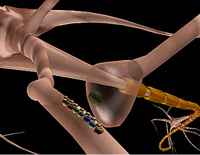
Microsystems and Nanotechnologies, 70 Angels Path, Webster, NY 14580-4400, U.S.A.
e-mail: E.Lyshevski@rit.edu

 |
Marina A. Lyshevski
Microsystems and Nanotechnologies, 70 Angels Path, Webster, NY 14580-4400, U.S.A. e-mail: E.Lyshevski@rit.edu |
 |
This paper studies Brownian dynamics with applications to nanobioelectronics and controlled atomic and molecular assembly. The cornerstone principles of the energy conversion and dynamic motion are examined using the multi-degree-of-freedom complementary electrochemomechanical bonding. We enhance the thermal ratchet probability-based concept. This bioinspired concept results in highly nonlinear equations of motion which describe a temporal-dynamic evolution. The studied molecular machines perform transport guarantying functionality of living cells. Thermal fluctuations can be the major source of energy for Brownian motion. Brownian motors transport biological materials, ions, build proteins, attain motility of the cell, engaged in actuation and activation, etc. Fluctuation-driven transport is studied applying the Brownian ratchet principle. This concept provides the understanding of how electrochemical energy converted into mechanical and other forms of energy. The importance of Brownian motion is its versatility in explaining a wide range of biological processes and examining the controlled energy conversion at molecular scale. This paper proposes an innovative molecular control mechanism for Brownian nanobioelectronics utilizing the complementary electrochemomechanical bonding and considering multi-molecules interactive dynamics. We report the Brownian transistor as a novel functional multi-terminal nanobioelectronic device for three-dimensional nanobiocircuits.